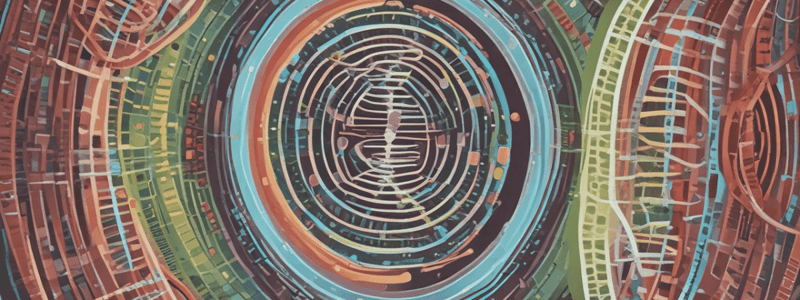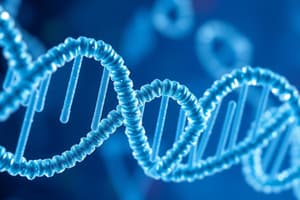Podcast
Questions and Answers
Che cosa è il clonaggio genico?
Che cosa è il clonaggio genico?
- Il processo di produzione di multiple copie di un gene o sequenza di DNA specifica (correct)
- Il processo di produzione di proteine utilizzando PCR
- Il processo di mappatura di un genoma
- Il processo di eliminazione di geni indesiderati da un organismo
Qual è il ruolo dei vettori di plasmidi nel clonaggio genico?
Qual è il ruolo dei vettori di plasmidi nel clonaggio genico?
- Portare il gene target nel nucleo dell'organismo ospite
- Produrre proteine utilizzando il gene clonato
- Caricare il DNA estraneo nell'organismo ospite (correct)
- Eliminare i geni indesiderati dall'organismo ospite
Come vengono isolate le copie del gene clonato?
Come vengono isolate le copie del gene clonato?
- Through purification of the host organism's chromosome
- Through the use of PCR
- Attraverso la trasformazione diretta dell'organismo ospite
- Attraverso la replica del plasmide nell'organismo ospite (correct)
Che cos'è la PCR?
Che cos'è la PCR?
Che vantaggio presentano i vettori di plasmidi rispetto ad altri vettori?
Che vantaggio presentano i vettori di plasmidi rispetto ad altri vettori?
Qual è il risultato finale del clonaggio genico?
Qual è il risultato finale del clonaggio genico?
Qual è il ruolo degli enzimi di restrizione nel clonaggio genico?
Qual è il ruolo degli enzimi di restrizione nel clonaggio genico?
Qual è lo step successivo alla ligation nel processo di clonaggio genico?
Qual è lo step successivo alla ligation nel processo di clonaggio genico?
In cosa consiste l'amplificazione nel contesto del clonaggio di geni?
In cosa consiste l'amplificazione nel contesto del clonaggio di geni?
Qual è l'importanza dell'uso di antibiotici nella fase di selezione nel processo di clonaggio genico?
Qual è l'importanza dell'uso di antibiotici nella fase di selezione nel processo di clonaggio genico?
Per quale motivo il clonaggio tramite PCR è utile quando il frammento di DNA di interesse è presente in quantità limitate?
Per quale motivo il clonaggio tramite PCR è utile quando il frammento di DNA di interesse è presente in quantità limitate?
In cosa consiste la trasformazione nel clonaggio di geni?
In cosa consiste la trasformazione nel clonaggio di geni?
Flashcards are hidden until you start studying
Study Notes
Recombinant DNA Technology: Cloning, Plasmids, and PCR
Recombinant DNA technology is a powerful tool in molecular biology that allows scientists to manipulate and study genes and DNA sequences. This technology has revolutionized the fields of genetics, biotechnology, and medicine by enabling the mass production of specific genes or DNA sequences. Three key techniques in recombinant DNA technology are gene cloning, plasmid vectors, and PCR (polymerase chain reaction).
Gene Cloning
Gene cloning is the process of producing multiple copies of a specific gene or DNA sequence. This is achieved by inserting the desired gene into a vector, typically a plasmid, which is then introduced into a host organism, such as bacteria. The host organism replicates the plasmid, resulting in multiple copies of the gene. These copies can then be easily isolated and used for various purposes, such as protein production, DNA sequencing, or functional studies.
Plasmid Vectors
Plasmid vectors are circular DNA molecules that are used to carry foreign DNA into host organisms. They are small, self-replicating elements found in bacteria, and they are often used as vectors in gene cloning. Plasmids are advantageous because they can be easily purified, transformed into host organisms, and replicate independently of the host chromosome.
The process of cloning genes using plasmid vectors involves several steps:
-
Digestion: The plasmid vector and the DNA fragment containing the gene of interest are cut with restriction enzymes, which create sticky ends on the DNA molecules.
-
Ligation: The sticky ends of the plasmid vector and the DNA fragment are joined together using DNA ligase, creating a recombinant plasmid containing the cloned gene.
-
Transformation: The recombinant plasmid is introduced into a host organism, such as E. coli, using a process called transformation.
-
Selection: The host organisms are grown in a medium containing an antibiotic that only allows the growth of cells carrying the recombinant plasmid. This ensures that only the cells containing the cloned gene are selected.
-
Amplification: The host organisms carrying the recombinant plasmid are grown in large quantities, allowing for the production of many copies of the cloned gene.
PCR (Polymerase Chain Reaction)
PCR is a powerful technique used to amplify specific DNA sequences. It involves three steps: denaturation, annealing, and extension. In the context of gene cloning, PCR can be used to amplify the DNA fragment of interest before cloning it into a plasmid vector. This can be particularly useful when the DNA fragment is present in limited quantities or when the cloning efficiency using traditional methods is low.
PCR cloning does not require restriction enzyme digestion, as the DNA fragments are amplified directly using PCR. The PCR product is then ligated to a vector, typically a plasmid, and transformed into a host organism for cloning. PCR cloning is a rapid and high-throughput method that can be particularly useful for cloning DNA fragments that are not available in large amounts.
In summary, recombinant DNA technology, including gene cloning, plasmid vectors, and PCR, has revolutionized the field of molecular biology and has numerous applications in genetics, biotechnology, and medicine. These techniques allow scientists to study and manipulate genes and DNA sequences in a controlled and efficient manner, leading to a better understanding of biological processes and the development of new technologies.
Studying That Suits You
Use AI to generate personalized quizzes and flashcards to suit your learning preferences.




